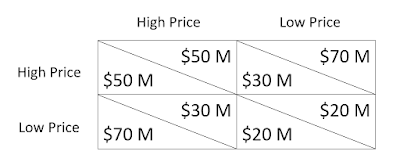Explain why prices tend to be relatively rigid in oligopolistic firms. [10 marks]
The given question is question 2.(a) from the November 2018 Economics Paper 1. N18/3/ECONO/HP1/ENG/TZ0/XX . For Question 2. (b), click here.
Oligopolistic firms are a small number of firms which have a relatively large control over the market share. There are two types of oligopoly- collusive and non-collusive. While all firms maximize their profits, they can either compete through price or non-price factors.
In a collusive
oligopoly, firms may either collude through formal or tacit collusion. In a
formal collusion, all the firms reach an agreement on a common price for their
products which is generally very high. All the firms may benefit from this
agreement, however, some who try to still benefit more may cheat and sell their
products at a lower price.
For instance, if two firms were originally selling their products and
receiving $20M each as profit, then after formally colluding, they could receive
a profit of $50M each. In game theory, the following situation can be shown as
given in the table above. Decisions of firm A are represented on top of the
table and on the side for firm B. Top right corners in cells show utility of
firm A and bottom left for B. Both firms are dependent on each other’s actions.
Clearly, it can be seen that if firm A breaks the agreement, it will benefit more, with $70M, and if it doesn’t do so, firm B might take the opportunity and A
will only receive $30M profits. B also thinks the same way. Therefore, both
might end up breaking the contract and receiving only $20M profit.
In formal collusion, thus, prices are generally rigid due to the
prisoner’s dilemma explained above. In tacit collusion, prices are fixed too. As either a leading firm decides the price that other firms
follow or all firms informally set a price less than that at profit-maximization
to create barriers to entry.
In non-collusive oligopoly, prices tend to be rigid due to a kinked
demand curve as shown in the diagram below.
As profit-maximisation is MR = MC, the intersection of the three marginal cost curves with the broken MR show costs for different firms at the same profit-maximisation price, P1, and quantity, Q1. If one of the firms were to decide that they must increase prices, the prices of other firms would still be the same. Consumers would rather buy from them thus a small increase in price would cause a big decrease in quantity demanded for that firm because PED > 1. Its profit would reduce.
Even if it reduces prices less than P1, other firms would enjoy greater profits as big decrease in price causes a small increase in quantity demanded shown by a PED < 1. This kinked demand curve thus causes a price rigidity.
As oligopolies generally have price rigidities, they tend to compete through non-price factors.





Thank you very helpful
ReplyDeleteVery helpful!!
ReplyDelete